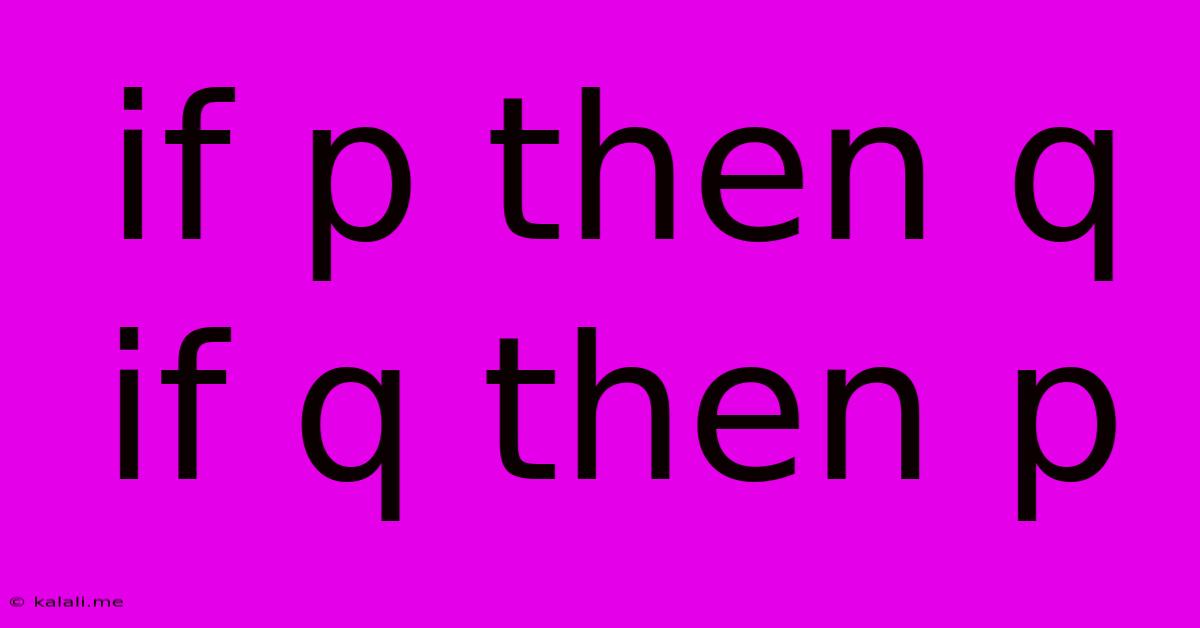If P Then Q If Q Then P
Kalali
Jun 10, 2025 · 3 min read

Table of Contents
If P Then Q, If Q Then P: Understanding Conditional Statements and Their Converse
This article explores the relationship between conditional statements and their converses, specifically focusing on the logical implications when we have "If P then Q" and "If Q then P." Understanding this distinction is crucial in logic, mathematics, and even everyday reasoning. We'll delve into the concepts of implication, converse, inverse, and contrapositive to clarify the nuances of these statements.
What is a Conditional Statement?
A conditional statement, also known as an implication, is a logical statement of the form "If P, then Q," often written as P → Q. P is the hypothesis (or antecedent), and Q is the conclusion (or consequent). This statement asserts that if P is true, then Q must also be true. However, it doesn't say anything about the truth of Q if P is false.
The Converse: Flipping the Hypothesis and Conclusion
The converse of the statement "If P then Q" is simply "If Q then P," or Q → P. It's crucial to understand that the truth of the original statement (P → Q) does not automatically guarantee the truth of its converse (Q → P). They are logically independent statements.
Let's illustrate with an example:
- Original Statement (P → Q): If it's raining (P), then the ground is wet (Q). This is generally true.
- Converse (Q → P): If the ground is wet (Q), then it's raining (P). This is false. The ground could be wet for other reasons (sprinkler, spilled water, etc.).
This example clearly shows that even if a conditional statement is true, its converse isn't necessarily true.
Inverse and Contrapositive: Further Transformations
Beyond the converse, we can also consider the inverse and contrapositive:
- Inverse: If not P, then not Q (¬P → ¬Q). The inverse negates both the hypothesis and conclusion of the original statement. Like the converse, the truth of the original statement doesn't guarantee the truth of its inverse.
- Contrapositive: If not Q, then not P (¬Q → ¬P). The contrapositive negates both parts of the statement and reverses the order. Importantly, the contrapositive is logically equivalent to the original statement. If one is true, the other is also true; if one is false, the other is also false.
Biconditional Statements: When Converse is True
If both a statement (P → Q) and its converse (Q → P) are true, we can combine them into a biconditional statement: "P if and only if Q," often written as P ↔ Q. This indicates that P and Q are logically equivalent; one is true if and only if the other is true. In our rain example, a biconditional statement wouldn't hold true because the ground being wet doesn't necessitate rain.
Practical Applications and Conclusion
Understanding the distinction between a statement and its converse is crucial for clear and accurate reasoning in various fields. Avoiding the fallacy of assuming the converse is true when it's not is essential for logical thinking. Careful analysis of conditional statements and their related forms is key to making sound judgments and avoiding logical errors. Always examine the implications of each statement independently and avoid making unwarranted assumptions.
Latest Posts
Latest Posts
-
Big Data Crypto Able To Share Cpu
Jun 10, 2025
-
Dress Hanging Closet Comes Out From Wall
Jun 10, 2025
-
How To See Blocked Messages On Mac
Jun 10, 2025
-
How To Repair Torn Leather Couch
Jun 10, 2025
-
How Many Ml In 100 Grams
Jun 10, 2025
Related Post
Thank you for visiting our website which covers about If P Then Q If Q Then P . We hope the information provided has been useful to you. Feel free to contact us if you have any questions or need further assistance. See you next time and don't miss to bookmark.